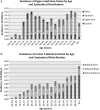The relative incidence of fracture non-union in the Scottish population (5.17 million): a 5-year epidemiological study
- PMID: 23396560
- PMCID: PMC3586107
- DOI: 10.1136/bmjopen-2012-002276
The relative incidence of fracture non-union in the Scottish population (5.17 million): a 5-year epidemiological study
Abstract
Objectives: In the UK there are approximately 850 000 new fractures seen each year. Rates of non-union of 5-10% of fractures have been suggested, the cost to the National Health Service of treating non-union has been reported to range between £7000 and £79 000 per person yet there are little actual data available. The objective of this epidemiological study therefore is for the first time to report the rates of fracture non-union.
Design: A cross-sectional epidemiological study.
Setting: The population of Scotland.
Participants: All patient admissions to hospital in Scotland are coded according to diagnosis. These data are collected by (and were obtained from) Information Services Department Scotland. Those who have been coded for a bone non-union between 2005 and 2010 were included in the study. No patients were excluded. Population data were obtained from the Registrar General for Scotland.
Outcome measure: The number of fracture non-unions per 100 000 population of Scotland according to age, sex and anatomical distribution of non-union.
Results: 4895 non-unions were treated as inpatients in Scotland between 2005 and 2010, averaging 979 per year, with an overall incidence of 18.94 per 100 000 population per annum. The distribution according to gender was 57% male and 43% female. The overall peak incidence according to age was between 30 and 40 years. The mean population of Scotland between 2005 and 2010 was 5 169 140 people.
Conclusion: Fracture non-union in the population as a whole remains low at less than 20 per 100 000 population and peaks in the fourth decade of life. Further research is required to determine the risk of non-union per fracture according to age/sex/anatomical distribution. .
Figures
References
-
- Mock C, Lormand JD, Goosen J, et al. Guidelines for essential trauma care. Geneva: World Health Organiziation, 2004
-
- Mock CN, Adzotor KE, Conklin E, et al. Trauma outcomes in the rural developing world: comparison with an urban level I trauma center. J Trauma 1993;35:518–23 - PubMed
-
- Sethi D, Racioppi F, Baumgarten I, et al. Reducing inequalities from injuries in Europe. Lancet 2006;368:2243–50 - PubMed
-
- Court-Brown C, Aitken SA, Forward D, et al. The epidemiology of adult fractures. In: Bucholz RW, Court-Brown C, Heckman JD, Tornetta P, eds. Rockwood and green's fractures in adults. 7th edn. Philidelphia: Lippincott Williams & Wilkins, 2010, 2009:53–84
LinkOut - more resources
Full Text Sources
Other Literature Sources
Molecular Biology Databases


